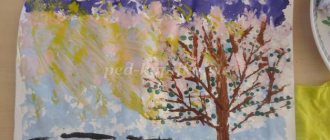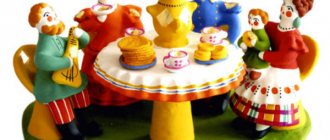Notes on speech development “Reading and memorizing poems about winter”
5
Lesson summary on speech development
Subject:
Reading and memorizing poems about winter.
Goal: To introduce children to poetry. Help children memorize and read poems expressively. Encourage children to memorize the poem.
1. Educational task: to promote the formation of the ability to conduct a dialogue with a teacher, to help learn how to answer questions about the content using lines from the text. To consolidate children's knowledge of the signs of winter while looking at the illustrations. Teach children to expressively read a poem by heart, understand and reproduce figurative language; develop expressive reading skills.
2. Developmental task: to develop internal motivation in children to listen to V. Orlov’s poem “Why does the bear sleep in winter? »
3. Educational: Arouse interest in poetry, awaken aesthetic feelings; promote a caring attitude towards toys.
4. Health: Creating conditions for physical activity of children. Evoke an emotional response to pictures of winter nature.
Methods and techniques.
1. Visual: (show, demonstration)
2. Verbal: artistic expression, conversation, story, questions, explanations.
3. Game: surprise moment.
Preliminary work.
Looking at illustrations about bears, reading fiction and educational literature, riddles about wild animals, word games.
Equipment: Envelope with a riddle, Teddy Bear toy. A riddle about winter, about a bear, a selection of illustrations on the theme “Winter”.
Progress of the lesson:
Children and teacher stand in a circle
.
Hello, my dears, both small and large! I see how you have grown - how good you are!
Educator. Guys, I see that you are in a great mood today. Let's give each other our happy smiles!
Now let's say hello to our guests.
And we will also give them our smiles!
Educator. Well done! Now we will have a wonderful mood all day.
Guys, what do I have in my hands?
Children. Envelope.
Educator. Guys, let's see what's inside. Riddle about winter:
Snow on the fields
Ice on the rivers
The blizzard is walking.
When does this happen?
Children's answers
Educator. That's right, guys. Look at what time of year is depicted.
Why do you think so?
What signs of winter do you know?
Do you love winter?
Winter is a wonderful time of year. Let's see how beautiful it is in winter!
(View reproductions of paintings by artists).
Educator. Guys, did you like winter nature? (Children's answers)
What colors did artists mainly use in their works?
Children. Blue, light blue, white.
Educator. Why?
Children. They depicted snow.
Educator. What kind of snow?
Children. White, cold, fluffy.
Learning poems using the method of modeling and “telling” with your hands
Vlasenko Tatyana Aleksandrovna Petrenko Olga Nikolaevna educators MADOU “Kindergarten of a combined type No. 7g. Shebekino, Belgorod region"
The material was sent for publication in the All-Russian printed collection of practice-oriented materials “Preschool and primary education - modern methods and technologies of teaching and upbringing” - OCTOBER 2021.
LEARNING POEMS USING THE METHOD OF MODELING AND “TELLING” WITH YOUR HANDS master class for teachers and parents
Teachers and parents understand that memorizing poems for a child has enormous benefits: the horizons expand, memory, phonemic hearing, vocabulary, coherent speech develop, and the pronunciation of sounds in syllables, words and phrasal speech is consolidated, the ability to control the voice (quiet, loud) is developed. ), facial muscles and intonation expressiveness of speech, artistic abilities are developed, and the cultural level of a small person is formed. By the way, the most favorable age for memorizing poetry for a child is 5-6 years old. But sometimes it is difficult for some children to memorize poems.
Advertising message
There are many ways and techniques for memorizing poetry.
Gestures and facial expressions.
Gestures and facial expressions play a significant role during the reading of a poem. To practice them, you can invite children to convey the content of poetic lines with expressive gestures.
The teacher, parent reads a poem, and the child “tells it with his hands.”
Preschoolers find especially accurate and very expressive gestures while reading Russian folk nursery rhymes and songs.
Children aged 5-6 years old, when offering poems to memorize, must be given the right to choose, their interests and capabilities taken into account.
In order for poems not to be forgotten, they need to be read as often as possible: in individual work with children, on walks, on holidays, evenings of relaxation, short moments of poetry, on family holidays, etc.
I would like to propose the use of schematic images of objects and actions for memorizing poems, since children usually use visual-figurative thinking to understand the world around them. The picture background that the child observes, simultaneously with the reading of the poem, helps to perceive the poem through two senses - visual and auditory, which means it is better to understand and remember it. For better memorization, even a simple schematic diagram of a line or semantic fragment is enough for a child.
I propose a step-by-step memorization of the poem:
- Before you start memorizing a poem, read it with expression. And if a teacher or parent learns it by heart, it will be just wonderful.
- Then be sure to explain unfamiliar or incomprehensible words and expressions to your child, using objects or pictures.
- After this, read the poem again, slowly, emphasizing the semantic points.
- After re-reading, show the portrait of the poet, tell the child about the author of this work, as well as how and when it was written. This approach facilitates the perception of poetry and develops systematic thinking.
- Be sure to look at the illustrations for the poem with your child and answer all his questions.
- Have a conversation about the content of the poem.
- Then read the poem again.
- Now, together with the children, draw schematic pictures for each or almost every line of the poem.
And after that, you can start memorizing the poem using hints - diagrams. Warn the children that you will learn this work by heart, motivate the child to memorize and read expressively.
Using the example of V. Semernin’s poem “It’s raining down the street,” tells and shows how to teach a child to memorize poems using mnemonic diagrams. Teachers and parents are divided into two subgroups and draw up diagrams based on the poems proposed by the teachers.
The wonderful poet V. Semernin loved autumn very much, he often walked around the autumn city, admired the falling leaves, listened to the sound of the rain, and once came up with the following poem:
“It’s raining down the street, The road is wet, There are a lot of drops on the glass, And there’s not much heat. Like autumn mushrooms, We carry umbrellas, Because it’s autumn outside.”
– Did you like the poem? – To help us learn it faster, let’s call our assistants here – “Pencil” and “Magic House”.
“Children” sit on chairs. A conversation is held on the content of the poem with filling out a mnemonic table.
– What autumn phenomenon is this poem talking about? – What does rain do in a poem? (It's raining down the street)
-What else can rain do? (rain drips, drizzles, knocks, pours, pours)
The teacher adds droplets for each word.
– What does everything look like after the rain? (wet, damp, humid)
– What became wet in the poem? How can we depict this? (puddles on the road)
– If we are sitting at home, how do we know that it is raining outside?
– What will our ears hear? What will our eyes see?
– What did the author of the poem see? (drops on glass)
– How did the author of the poem feel? (the sun gives a little warmth)
– What word can replace the word “a little”? (a little, a little - a little)
A game exercise is carried out: “One and many” (words from the poem are used)
Educator: one road
“Children” answer: many roads, one puddle - many puddles, one cloud - many clouds, one street - many streets, one drop - many drops, one umbrella - many umbrellas, one mushroom - many mushrooms.
– What comparison can be found in the poem? (mushrooms and people with umbrellas).
– Now be careful! What mushrooms is the author of the poem talking about, choose the correct word: edible, inedible, autumn, summer.
- Well done, you are very attentive!
– Why did the author want to write such a poem? (because autumn has come; this is his favorite time of year; because autumn is beautiful, even if it rains; he loved walking in the rain under an umbrella; he loved looking at the flowing drops)
A recording with the sounds of rain is turned on, the “children” move to the center of the group, the teacher opens an umbrella over the children’s heads.
-What kind of rain is it? (children’s answers: cold, warm, small, large, strong, torrential, cover, autumn).
The teacher offers to arrange the pictures sequentially and recite the poet’s poem.
Note: To complicate the task, an exercise is carried out: “Tell it loudly, tell it quietly.” “Children” lay out pieces of paper with pictures on the carpet in the right order and, together with the teacher, recite a poem with varying voice strengths, paying attention to the movement of the piece of paper in the teacher’s hands (if the piece of paper flies up, it’s loud, if down, it’s quiet).
– Poems can be told in different ways. I suggest you choose a cloud - a mask - and tell the poem expressively, with different emotions - sad, cheerful, calm, angry.
Note: One cloud without indicating an emotion - when telling a poem, the child must independently choose an emotion.
A game exercise is carried out: “I am a cloud.” The teacher and “children” stand in a circle. A “child” wearing a mask stands in the middle of the circle. He must name the emotion depicted on the cloud.
All the “children” walk in a circle, holding hands, and say: “An angry (cheerful, sad, thoughtful, surprised, etc.) cloud floated across the sky, she threw drops on the ground, that’s what she told us all.”
The “child” recites the poem emotionally, after which the teacher offers to give an assessment by clapping their hands (the better the poem is told, the louder the “children” clap their hands).
– That’s how great it was for you to recite our new poem!
You can see the table of authors and learn more about the collections HERE





